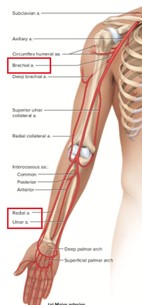Which action should the nurse take when the low-pressure alarm sounds for a patient who has an arterial line in the right radial artery?
Check the right hand for rash.
Assess the waveform for under-dampening
Assess for cardiac dysrhythmias.
Rezero the monitoring equipment.
The Correct Answer is D
When the low-pressure alarm sounds, it indicates that the pressure being detected by the arterial line is below the set threshold. This could be due to a variety of reasons, such as a loose connection, air bubbles, or a shift in the zero-reference point.
Rezeroing the monitoring equipment involves recalibrating or resetting the baseline reference point for the arterial pressure waveform. This ensures accurate measurement and monitoring of the patient's arterial pressure.
A. Checking the right hand for a rash in (option A) is incorrect because While assessing the patient for any skin changes or rashes is important, it is not the first action to take in response to a low-pressure alarm.
B. Assessing the waveform for under-dampening in (option B) is incorrect because Assessing the waveform characteristics is important in arterial line monitoring, but it may not be the initial action when the low-pressure alarm sounds. Rezeroing the equipment should be performed before assessing waveform characteristics.
C. Assessing for cardiac dysrhythmias in (option C) is incorrect because Assessing for dysrhythmias is an important aspect of patient care, but it may not be directly related to the low-pressure alarm from the arterial line. Rezeroing the monitoring equipment takes precedence.
Therefore, when the low-pressure alarm sounds for a patient with an arterial line, the nurse should first re-zero the monitoring equipment to ensure accurate measurement of arterial pressure.

Nursing Test Bank
Naxlex Comprehensive Predictor Exams
Related Questions
Correct Answer is A
Explanation
The ABG results show a pH of 7.50, PaCO2 of 29 mmHg, and HCO3 of 23 mEq/L, indicating respiratory alkalosis. In respiratory alkalosis, there is a decrease in PaCO2 (hypocapnia), which can be caused by excessive ventilation.
To address the respiratory alkalosis, the nurse should decrease the respiratory rate. This would help reduce the amount of ventilation provided and allow the patient to retain more carbon dioxide (CO2), thereby increasing the PaCO2 levels and restoring acid-base balance.
B. Leaving the ventilator at the current settings in (option B) is incorrect because it may exacerbate respiratory alkalosis as it would maintain the same level of ventilation.
C. Increasing the tidal volume (VT) in (option C) is incorrect because it would not address the respiratory alkalosis. Tidal volume refers to the volume of air delivered with each breath, while the issue in this case is excessive ventilation leading to hypocapnia.
D. Increasing the FiO2 (fraction of inspired oxygen) in (option D) is incorrect because it is not indicated based on the given ABG results. The oxygenation (PaO2) level is within normal limits (80 mmHg), suggesting adequate oxygenation.
It is important to consult with the healthcare provider or respiratory therapist for further guidance on adjusting the ventilator settings based on the patient's condition and response to therapy.
Correct Answer is B
Explanation
Fresh frozen plasma (FFP) is a blood product that contains various clotting factors, including factors II, V, VII, VIII, IX, X, XI, and XIII. These clotting factors are essential for the normal coagulation process. In patients with shock, coagulation abnormalities can occur, and administration of FFP can help replenish the deficient clotting factors and restore proper coagulation function.
The other options mentioned are not the primary components replaced by fresh frozen plasma:
A. Red blood cells are in (option A) is incorrect because Red blood cells carry oxygen and are typically replaced by packed red blood cell transfusions in cases of significant blood loss or anemia. Fresh frozen plasma does not contain a significant amount of red blood cells.
C. Platelets in (option C) is incorrect because: Platelets play a role in blood clotting and are typically replaced by platelet transfusions in cases of thrombocytopenia or platelet dysfunction. Fresh frozen plasma may contain a small number of platelets but is not the primary source for platelet replacement.
D. White blood cells in (option D) is incorrect because White blood cells are part of the immune system and are not typically replaced using fresh frozen plasma. Fresh frozen plasma does not contain a significant amount of white blood cells.
Therefore, fresh frozen plasma is primarily administered to patients in shock to replace clotting factors and help restore proper coagulation function.
Whether you are a student looking to ace your exams or a practicing nurse seeking to enhance your expertise , our nursing education contents will empower you with the confidence and competence to make a difference in the lives of patients and become a respected leader in the healthcare field.
Visit Naxlex, invest in your future and unlock endless possibilities with our unparalleled nursing education contents today
Report Wrong Answer on the Current Question
Do you disagree with the answer? If yes, what is your expected answer? Explain.
Kindly be descriptive with the issue you are facing.
